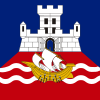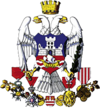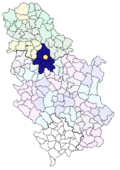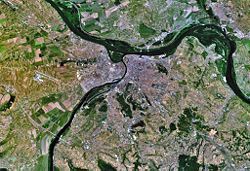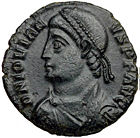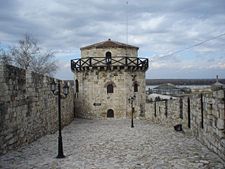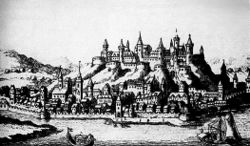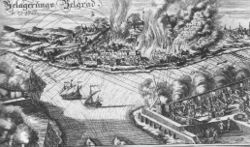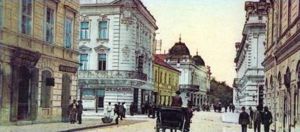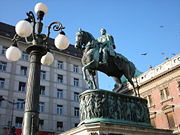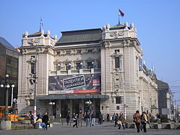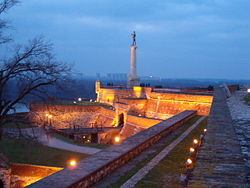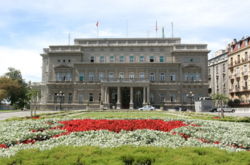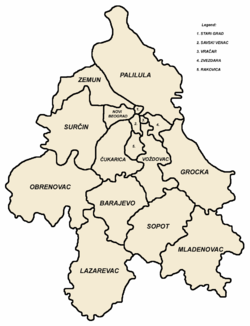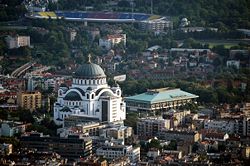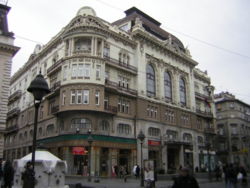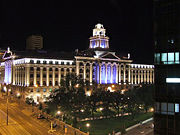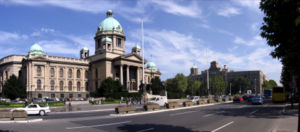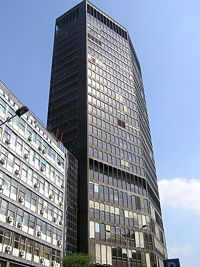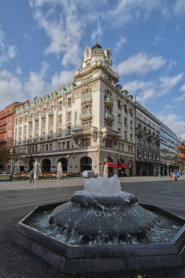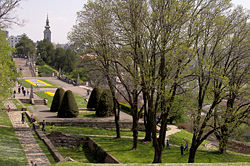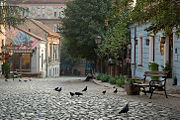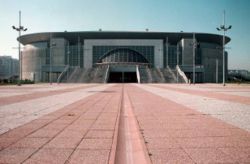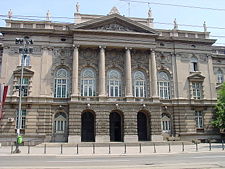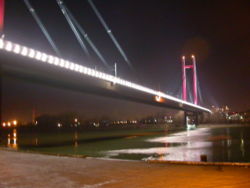Belgrade
2008/9 Schools Wikipedia Selection. Related subjects: Europe; European Cities
| Belgrade Београд Beograd |
|||
| City of Belgrade | |||
| Aerial view of Belgrade downtown and river shores | |||
|
|||
| Location of Belgrade within Serbia | |||
| Coordinates: | |||
|---|---|---|---|
| Country | |||
| District | City of Belgrade | ||
| Municipalities | 17 | ||
| Founded | 269 B.C. | ||
| City rights | 150 A.D. | ||
| Government | |||
| - Mayor | Branislav Belić ( DS) (acting) | ||
| - Ruling parties (interim) | DS/ G17+/ SPS/ LDP | ||
| Area | |||
| - City | 3,222.68 km² (1,244.3 sq mi) | ||
| - Urban | 1,035.0 km² (399.6 sq mi) | ||
| Elevation | 117 m (384 ft) | ||
| Population (2008.) | |||
| - City | 2 500 000 | ||
| - Density | 7,450/km² (19,295.4/sq mi) | ||
| - Urban | 2 000 000 | ||
| - Urban Density | 4,880/km² (12,639.1/sq mi) | ||
| Time zone | CET ( UTC+1) | ||
| - Summer ( DST) | CEST ( UTC+2) | ||
| Postal code | 11000 | ||
| Area code(s) | (+381) 11 | ||
| Car plates | BG | ||
| Website: www.beograd.rs | |||
Belgrade ( Serbian: Београд, Beograd listen ), is the capital and largest city of Serbia. The city lies at the confluence of the Sava and Danube Rivers in north central Serbia, where the Pannonian Plain meets the Balkan Peninsula. With a population of over 1.9 million (estimate 2008), Belgrade is the largest city in the territory of the former Yugoslavia and the fourth largest in Southeastern Europe, after Istanbul, Athens, and Bucharest.
One of Europe's oldest cities, with a history of 7,000 years Belgrade's wider city area was the birthplace of the largest prehistoric culture of Europe, the Vinča culture. The foundation of the city itself dates back to Celtic and later, Roman periods, followed by the settlement of Slavs around the 7th century. In medieval times, it was in the possession of Byzantine, Frankish, Bulgarian, Hungarian and Serbian rulers, until it was conquered by the Ottomans in 1521 and became the seat of the Pashaluk of Belgrade. It became the capital of an independent Serbian state for the first time in 1284 (lost to Hungary in 1427), the status that it would regain only in 1841, after the liberation from the Ottomans. In the 20th century, it was also the capital of several incarnations of Yugoslavia, up to 2006, when Serbia became an independent state again.
Belgrade has the status of a separate territorial unit in Serbia, with its own autonomous city government. Its territory is divided into 17 municipalities, each having its own local council. It covers 3.6% of the territory of Serbia, and 21% of the Serbian population lives in the city. Belgrade is the central economic hub of Serbia, and the capital of Serbian culture, education and science.
Geography
Belgrade lies 116.75 metres (383 ft) above sea level and is located at the confluence of the Danube and Sava rivers, at coordinates 44°49'14" North, 20°27'44" East. The historical core of Belgrade (today's Kalemegdan) is on the right bank of the rivers. Since the 19th century, the city has been expanding to the south and east, and after World War II, New Belgrade was built on the Sava's left bank, merging Belgrade with Zemun. Smaller, chiefly residential communities across the Danube, like Krnjača and Ovča, also merged with the city. The city has an urban area of 360 square kilometres (139 sq mi), while together with its metropolitan area it covers 3,223 km² (1,244.4 sq mi). Throughout history, Belgrade has been a major crossroad between the West and the Orient.
On the right bank of the Sava, central Belgrade has hilly terrain, while the highest point of Belgrade proper is Torlak hill at 303 m (994 ft). The mountains of Avala (511 m (1,677 ft)) and Kosmaj (628 m (2,060 ft)) lie south of the city. Across the Sava and Danube, the land is mostly flat, consisting of alluvial plains and loessial plateaus.
Climate
| Climate chart for Belgrade | |||||||||||
|---|---|---|---|---|---|---|---|---|---|---|---|
| J | F | M | A | M | J | J | A | S | O | N | D |
|
49
4
-2
|
44
6
0
|
50
12
3
|
59
18
8
|
71
23
12
|
90
25
15
|
66
27
16
|
51
27
16
|
51
24
13
|
40
18
8
|
54
11
4
|
58
5
0
|
| temperatures in °C precipitation totals in mm source: Climate-Charts.com |
|||||||||||
|
Imperial conversion
|
|||||||||||
Belgrade has a moderate continental climate. The year-round average temperature is 11.7 ℃ (53.1 ℉), while the hottest month is July, with an average temperature of 22.1 ℃ (71.8 ℉). There are, on average, 31 days a year when the temperature is above 30°C, and 95 days when the temperature is above 25°C. Belgrade receives about 700 millimetres (27.56 in) of precipitation a year. The average annual number of sunny hours is 2,096. The sunniest months are July and August, with an average of about 10 sunny hours a day, while December and January are the gloomiest, with an average of 2–2.3 sunny hours a day. The highest ever recorded temperature in Belgrade was +43,1 °C, while on the other end, the lowest temperature was -26.2 °C on January 10th, 1893.
History
Ancient city
The Neolithic Starčevo and Vinča cultures existed in or near Belgrade and dominated the Balkans (as well as parts of Central Europe and Asia Minor) about 7,000 years ago. Settled in the fourth century BC by a Celtic tribe, the Scordisci, the city's first recorded name was Singidūn, before becoming the Roman settlement of Singidunum in the first century AD.
In the mid 2nd century, the city was proclaimed a municipium by the Roman authorities, evolving into a full fledged colonia (highest class Roman city) by the end of the century. The first Christian Emperor of Rome was born in modern Serbia: Constantine I known as Constantine the Great ( Naissus, 280 A.D.) and a Roman Emperor was born in Belgrade, Jovian, the restorer of Christianity, Flavius Iovianus, ( Singidunum, 332 A.D.) Jovian reestablished Christianity as the official religion of the Roman Empire, ending the brief revival of paganism under his predecessor Julian. In 395 AD, the site passed to the Eastern Roman or Byzantine Empire. Across the Sava from Singidunum was the Celtic city of Taurunum (Zemun), that through Roman and Byzantine times shared a common fate with its "twin brother" (the two cities were connected by a bridge).
Middle Ages
Singidunum was occupied and often ravaged by successive invasions of Huns, Sarmatians, Ostrogoths and Avars before the arrival of the Slavs around 630 AD. The Avars were finally destroyed in the 9th century by the Frankish Kingdom, which incorporated the former Taurunum into its territory (renaming it to Malevilla). At the same time (around 878), the first record of the Slavic name Beligrad has appeared, during the rule of the First Bulgarian Empire. For about four centuries, the city remained a battleground between the Byzantine Empire, the Kingdom of Hungary and the First Bulgarian Empire. The city hosted the armies of the First and the Second Crusade; while passing through during the Third Crusade, Frederick Barbarossa and his 190,000 crusaders saw Belgrade in ruins. Capital of the Kingdom of Syrmia since 1284, the first Serbian king to rule over Belgrade was Dragutin, who received it as a gift from his father-in-law, the Hungarian king Stephen V. Following the Battle of Maritsa in 1371, and the Battle of Kosovo in 1389, the Serbian Empire began to crumble as the Ottoman Empire conquered its southern territory. The north, however, resisted through the Serbian Despotate, which had Belgrade as its capital. The city flourished under despot Stefan Lazarević, son of the famous Serbian ruler Lazar Hrebeljanović. Lazarević built a castle with a citadel and towers, of which only the Despot's tower and the west wall remain. He also refortified the city's ancient walls, allowing the Despotate to resist the Ottomans for almost 70 years. During this time, Belgrade was a haven for the many Balkan peoples fleeing from Ottoman rule, and is thought to have had a population of some 40–50,000.
In 1427, Stefan's successor Đurađ Branković had to return Belgrade to the Hungarians, and the capital was moved to Smederevo. During his reign, the Ottomans captured most of the Serbian Despotate, unsuccessfully besieging Belgrade first in 1440 and again in 1456. As it presented an obstacle to their further advance into Central Europe, over 100,000 Ottoman solders have launched the famous Siege of Belgrade, where the Christian army under John Hunyadi successfully defended the city from the Ottomans, wounding the Sultan Mehmed II This battle "decided the fate of Christendom"; the noon bell ordered by Pope Callixtus III commemorates the victory throughout the Christian world to this day.
Turkish conquest / Austrian invasions
It wasn't until 28 August 1521 (7 decades after the last siege), that the fort was finally captured by Sultan Suleyman the Magnificent and his 250,000 soldiers; subsequently, most of the city was razed to the ground and its entire Christian population deported to Istanbul. Belgrade was made the seat of the district ( Sanjak), attracting new inhabitants— Turks, Armenians, Greeks, Ragusan traders, and others, and there was peace for the next 150 years. The city became the second largest Ottoman town in Europe at over 100,000 people, surpassed only by Constantinople. Turkish rule also introduced Ottoman architecture to Belgrade and many mosques were built, increasing the city's Oriental influences. In 1594, a major Serb rebellion was crushed by the Turks. Further on, Albanian- born Grand vizier Sinan Pasha ordered the relics of Saint Sava to be publicly torched on the Vračar plateau; more recently, the Temple of Saint Sava was built to commemorate this event. In retaliation for the rebellion, most of the city's population was deported to Istanbul; the Belgrade Forest is, centuries on, still named after those Serbian refugees.
Occupied by Austria three times (1688–1690, 1717–1739, 1789–1791), headed by the Holy Roman Princes Maximilian of Bavaria and Eugene of Savoy, respectively, Belgrade was quickly recaptured and substantially razed each time by the Ottomans. During this period, the city was affected by the two Great Serbian Migrations, in which hundreds of thousands of Serbs, led by their patriarchs, retreated together with the Austrians into the Habsburg Empire, settling in today's Vojvodina and Slavonia.
Serbian capital
During the First Serbian Uprising, the Serbian revolutionaries held the city from 8 January 1806 until 1813, when it was retaken by the Ottomans. After the Second Serbian Uprising in 1817, Serbia reached semi-independence, which was formally recognized by the Porte in 1830. In 1841, Prince Mihailo Obrenović moved the capital from Kragujevac to Belgrade.
With the Principality's full independence in 1878, and its transformation into the Kingdom of Serbia in 1882, Belgrade once again became a key city in the Balkans, and developed rapidly. Nevertheless, conditions in Serbia as a whole remained those of an overwhelmingly agrarian country, even with the opening of a railway to Niš, Serbia's second city, and in 1900 the capital had only 69,100 inhabitants. Yet by 1905 the population had grown to more than 80,000, and by the outbreak of World War I in 1914, it had surpassed the 100,000 citizens, not counting Zemun which then belonged to Austria-Hungary.
The first-ever projection of motion pictures in the Balkans and Central Europe was held in Belgrade in June 1896 by Andre Carr, a representative of the Lumière brothers. He shot the first motion pictures of Belgrade in the next year; however, they have not been preserved.
World War I / Unified city
| " Kalemegdan is the prettiest and most courageous piece of optimism I know." Rebecca West in 1913 |
Gavrilo Princip's assassination of Archduke Franz Ferdinand of Austria and his wife Sophie, Duchess of Hohenberg, in Sarajevo on 28 June 1914 triggered World War I. Most of the subsequent Balkan offensives occurred near Belgrade. Austro-Hungarian monitors shelled Belgrade on 29 July 1914, and it was taken by the Austro-Hungarian Army under General Oskar Potiorek on 30 November. On 15 December, it was re-taken by Serbian troops under Marshal Radomir Putnik. After a prolonged battle which destroyed much of the city, between 6 October and 9 October 1915, Belgrade fell to German and Austro-Hungarian troops commanded by Field Marshal August von Mackensen on 9 October 1915. The city was liberated by Serbian and French troops on 5 November 1918, under the command of Marshal Louis Franchet d'Espérey of France and Crown Prince Alexander of Serbia. Decimated as the front-line city, for a while it was Subotica that was the largest city in the Kingdom; still, Belgrade grew rapidly, retrieving its position by the early 1920s.
After the war, Belgrade became the capital of the new Kingdom of Serbs, Croats and Slovenes, renamed the Kingdom of Yugoslavia in 1929. The Kingdom was split into banovinas, and Belgrade, together with Zemun and Pančevo, formed a separate administrative unit.
During this period, the city experienced faster growth and significant modernisation. Belgrade's population grew to 239,000 by 1931 (incorporating the town of Zemun, formerly in Austria-Hungary), and 320,000 by 1940. The population growth rate between 1921 and 1948 averaged 4.08% a year. In 1927, Belgrade's first airport opened, and in 1929, its first radio station began broadcasting. The Pančevo Bridge, which crosses the Danube, was opened in 1935.
World War II
On 25 March 1941, the government of regent Crown Prince Paul signed the Tripartite Pact, joining the Axis powers in an effort to stay out of the Second World War. This was immediately followed by mass protests in Belgrade and a military coup d'état led by Air Force commander General Dušan Simović, who proclaimed King Peter II to be of age to rule the realm. Consequently, the city was heavily bombed by the Luftwaffe on 6 April 1941, and up to 17,000 citizens were killed. Yugoslavia was then invaded by German, Italian, Hungarian, and Bulgarian forces, and suburbs as far east as Zemun, in the Belgrade metropolitan area, were incorporated into a Nazi puppet state, the Independent State of Croatia. Belgrade became the seat of another puppet government, headed by General Milan Nedić.
During the summer and fall of 1941, in reprisal for guerrilla attacks, Germans carried out several massacres of Belgrade citizens; in particular, members of the Jewish community were subject to mass shootings at the order of General Franz Böhme, the German Military Governor of Serbia. Böhme rigorously enforced the rule that for every German killed, 100 Serbs or Jews would be shot.
Belgrade was bombed by the Allies on 16 April 1944, killing about 1,600 people. Both this and the earlier Luftwaffe bombing fell on the Orthodox Christian Easter. Most of the city remained under German occupation until 20 October 1944, when it was liberated by Communist Yugoslav Partisans and the Red Army. On 29 November 1945, Marshal Josip Broz Tito proclaimed the Federal People's Republic of Yugoslavia in Belgrade (later to be renamed to Socialist Federal Republic of Yugoslavia on 7 April 1963).
During the post-war period, Belgrade grew rapidly as the capital of the renewed Yugoslavia, developing as a major industrial centre. In 1958, Belgrade's first television station began broadcasting. In 1961, the conference of Non-Aligned Countries was held in Belgrade under Tito's chairmanship. In 1968, major student protests against Tito led to several street clashes between students and the police, ending with Tito's famous saying, "Students are right!". In March 1972, Belgrade was at the centre of the last major outbreak of smallpox in Europe, which, through enforced quarantine and mass vaccination, was contained by late May.
Post-communist history
On 9 March 1991, massive demonstrations led by Vuk Drašković were held in the city against Slobodan Milošević. According to various media outlets, there were between 100,000 and 150,000 people on the streets. Two people were killed, 203 injured and 108 arrested during the protests, and later that day tanks were deployed onto the streets to restore order. Further protests were held in Belgrade from November 1996 to February 1997 against the same government after alleged electoral fraud at local elections. These protests brought Zoran Đinđić to power, the first mayor of Belgrade since World War II who did not belong to the League of Communists of Yugoslavia or its later offshoot, the Socialist Party of Serbia.
The NATO bombing during the Kosovo War in 1999 caused substantial damage to the city. Among the sites bombed were the buildings of several ministries, the RTS building, which killed 16 technicians, several hospitals, the Jugoslavija Hotel, the Central Committee building, the Avala TV Tower, and the Chinese embassy.
After the elections in 2000, Belgrade was the site of major street protests, with over half a million people on the streets (800,000 by police estimates, over 1,000,000 according to Misha Glenny). These demonstrations resulted in the ousting of president Milošević.
Names through history
| Name | Notes |
|---|---|
| Singidūn(on) | Named by the Celtic tribe of the Scordisci; dūn(on) means 'lodgment, enclosure, fort'; 279 BC |
| Singidūnum | Romans conquered the city and Romanised the Celtic name |
| Beograd, Београд | Slavic name first mentioned in 878 as Beligrad in the letter of Pope John VIII to Boris of Bulgaria which means "White city / white fortress". |
| Alba Graeca, "Alba" may be derived from the Latin word for "white" | Latin |
| Dar Ul Jihad | Ottoman Turkish "House of War" |
| Alba Bulgarica | Latin name during the period of Bulgarian rule over the city |
| Weißenburg and Griechisch-Weißenburg | German translation. Modern German is Belgrad. |
| Castelbianco | Italian translation |
| Nandoralba | In medieval Hungary up to the 14th century |
| Nándorfehérvár, Landorfehérvár | In medieval Hungary. Modern Hungarian is Belgrád. |
| Veligrad(i)on or Velegrada/Βελέγραδα | Byzantine name. Modern Greek is Veligradi (Βελιγράδι). |
Government and politics
Belgrade is a separate territorial unit in Serbia, with its own autonomous city government. The post of mayor was held by the Democratic Party member Nenad Bogdanović from 2004 and until his death on 27 September 2007. The first mayor to be democratically elected after World War II was Dr. Zoran Đinđić, in 1996. Mayors were also elected democratically prior to the war.
The Civic Assembly of Belgrade has 110 councilors who are elected for four-year terms. The current majority parties are the same as in the Parliament of Serbia ( Democratic Party- G17 Plus and Socialist Party of Serbia- Party of United Pensioners of Serbia with the support of Liberal Democratic Party), and in similar proportions, with the Serbian Radical Party and the Democratic Party of Serbia- New Serbia in opposition.
Municipalities
The city is divided into 17 municipalities, ten with "urban" status, and seven with "suburban" status. While each has its own local council, the suburban municipalities have slightly expanded municipal powers, mainly with regard to construction, town planning and public utility provision.
Most of the municipalities are situated on the southern side of the Danube and Sava rivers, in the Šumadija region. Three municipalities ( Zemun, Novi Beograd, and Surčin) are on the northern bank of the Sava, in the Syrmia region, and the municipality of Palilula, spanning the Danube, is in both the Šumadija and Banat regions.
| Name | Area (km²) | Population (1991) | Population (2002) | Urban/Suburban | |
|---|---|---|---|---|---|
| Barajevo | 213 | 20,846 | 24,641 | Suburban | |
| Čukarica | 156 | 150,257 | 168,508 | Urban | |
| Grocka | 289 | 65,735 | 75,466 | Suburban | |
| Lazarevac | 384 | 57,848 | 58,511 | Suburban | |
| Mladenovac | 339 | 54,517 | 52,490 | Suburban | |
| Novi Beograd | 41 | 218,633 | 217,773 | Urban | |
| Obrenovac | 411 | 67,654 | 70,975 | Suburban | |
| Palilula | 451 | 150,208 | 155,902 | Urban | |
| Rakovica | 31 | 96,300 | 99,000 | Urban | |
| Savski Venac | 14 | 45,961 | 42,505 | Urban | |
| Sopot | 271 | 19,977 | 20,390 | Suburban | |
| Stari Grad | 5 | 68,552 | 55,543 | Urban | |
| Surčin | 285 | Part of Zemun municipality until 2004. |
55,000 (est.) | Suburban | |
| Voždovac | 148 | 156,373 | 151,768 | Urban | |
| Vračar | 3 | 67,438 | 58,386 | Urban | |
| Zemun | 154 | 176,158 | 136,645 | Urban | |
| Zvezdara | 32 | 135,694 | 132,621 | Urban | |
| TOTAL | 3227 | 1,552,151 | 1,576,124 | ||
|
|
|||||
Demographics
Belgrade has a population of over 1,500 000 as recorded in the 2008. The main ethnic groups are Serbs (1,203 045), Montenegrins (25,000), Roma (19,000), Croats (7,000), Macedonians (8,372), and Muslims by nationality (4,617). Recent polls (2007) show that Belgrade's population has increased by 400,000 in just five years since the last official Census was undertaken. As of December 15th 2007, the city's Institute for Informatics and Statistics has registered 1,531,741 eligible voters, which confirms that Belgrade's population has risen dramatically since the 2002 Census, as the number of the registered voters has almost surpassed the entire population of the city six years before. According to the NGO Differentia, Belgrade has reached 2 million citizens as of 2007. The official Census has yet to confirm these figures.
Belgrade is home to many ethnicities from all over the former Yugoslavia, largely because it was the capital. Many people came seeking a better life, or fled as refugees from war and ethnic cleansing. Between 10,000 and 20,000 Chinese are estimated to live in Belgrade; they began immigrating in the mid-1990s. Blok 70 in New Belgrade is known locally as the Chinese quarter. Many Middle Easterners, mainly from Syria, Iran, Jordan and Iraq, arrived in order to pursue their studies during the 1970s and 1980s, and have remained and started families in the city. Afghani and Iraqi Kurdish refugees are among some of the recent arrivals from the Middle East.
Although there are several historic religious communities in Belgrade, the religious makeup of the city is relatively homogenous. The Serbian Orthodox community is by far the largest, with 1,429,170 adherents. There are also 20,366 Muslims, 16,305 Roman Catholics, and 3,796 Protestants. There used to be a significant Jewish community, but following the Nazi occupation, and many Jews' subsequent emigration to Israel, their numbers have fallen to a mere 515.
Economy
Belgrade is the most economically developed part of Serbia, and is home to the country's National Bank. Many notable companies are based in Belgrade, including Jat Airways, Telekom Srbija, Telenor Serbia, Delta Holding, regional centers for Société Générale, Intel, Motorola, Kraft Foods , Carlsberg , Microsoft, Zepter, Japan Tobacco and many others.
The troubled transition from the former Yugoslavia to the Federal Republic during the early 1990s left Belgrade, like the rest of the country, severely affected by an internationally imposed trade embargo. The hyperinflation of the Yugoslav dinar, the highest inflation ever recorded in the world, decimated the city's economy. Yugoslavia overcame the problems of inflation in the mid 1990s, and Belgrade has been growing strongly ever since. Today, over 30% of Serbia's GDP is generated by the city, which also has over 30% of Serbia's employed population. The average monthly income per capita is 47.500 RSD (€572, $903). This equates to a GDP per capita of €6,864 and $10,836. Purchasing power parity (PPP) is $18,204. According to the Eurostat methodology, 45.4% of the city's households own a computer (surpassing all of the regional capitals). According to the same survey, 39.1% of Belgrade's households have an internet connection; these figures are above those of the regional capitals such as Sofia, Bucharest and Athens.
Culture
Belgrade hosts many annual cultural events, including FEST (Belgrade Film Festival), BITEF (Belgrade Theatre Festival), BELEF (Belgrade Summer Festival), BEMUS (Belgrade Music Festival), Belgrade Book Fair, and the Belgrade Beer Festival. The Nobel prize winning author Ivo Andrić wrote his most famous work, The Bridge on the Drina, in Belgrade. Other prominent Belgrade authors include Branislav Nušić, Miloš Crnjanski, Borislav Pekić, Milorad Pavić and Meša Selimović. Most of Serbia's film industry is based in Belgrade; the 1995 Palme d'Or winning Underground, directed by Emir Kusturica, was produced in the city.
The city was one of the main centres of the Yugoslav New Wave in the 1980s: VIS Idoli, Ekatarina Velika and Šarlo Akrobata were all from Belgrade. Other notable Belgrade rock acts include Riblja Čorba, Bajaga i Instruktori and others. The city was the main centre former Yugoslavia of a musical style known as turbofolk, one of whose most famous stars is Ceca Ražnatović. Today, it is the centre of the Serbian hip hop scene, with acts such as Beogradski Sindikat, Škabo, Marčelo, and most of the Bassivity Music stable hailing from or living in the city. There are numerous theatres, the most prominent of which are National Theatre, Theatre on Terazije, Yugoslav Drama Theatre, Zvezdara Theatre, and Atelier 212. The Serbian Academy of Sciences and Arts is also based in Belgrade, as well as the National Library of Serbia. Belgrade's two opera houses are: National Theatre and Madlenijanum Opera House.
There are many foreign cultural institutions in Belgrade, including Instituto Cervantes, Goethe-Institut and the Centre Culturel Français, which are all located on Prince Michael Street. Other cultural centres in Belgrade are American Corner, the Austrian Cultural Forum (Österreichischen Kulturforums), the British Council, and Russian Centre for Science and Culture (Российский центр науки и культуры), the Confucius Institute, the Canadian Cultural Centre, the Italian Cultural Institute (Istituto Italiano di Cultura), and the Culture Centre of Islamic Republic of Iran.
Following the victory of Serbia's representative Marija Šerifović at the Eurovision Song Contest 2007, Belgrade hosted the Eurovision Song Contest 2008.
Museums
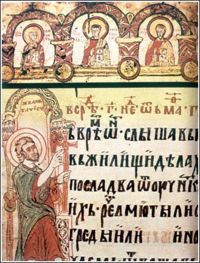
The most prominent museum in Belgrade is the National Museum, founded in 1844; it houses a collection of more than 400,000 exhibits,(over 5600 paintings and 8400 drawings and prints) including many foreign masterpieces and the famous Miroslavljevo Jevanđelje (Miroslav's Gospel). The Military Museum houses a wide range of more than 25,000 military exhibits dating as far back as to the Roman period, as well as parts of a F-117 stealth aircraft shot down by Yugoslav forces. The Museum of Aviation in Belgrade has more than 200 aircraft, of which about 50 are on display, and a few of which are the only surviving examples of their type, such as the Fiat G.50. This museum also displays parts of shot down US and NATO aircraft. The Ethnographic Museum, established in 1901, contains more than 150,000 items showcasing the rural and urban culture of the Balkans, particularly the countries of the former Yugoslavia. The Museum of Contemporary Art has a collection of around 8,540 works of art produced in Yugoslavia since 1900. The Nikola Tesla Museum, founded in 1952, preserves the personal items of Nikola Tesla, the inventor after whom the Tesla unit was named. It holds around 160,000 original documents and around 5,700 other items. The last of the major Belgrade museums is the Museum of Vuk and Dositej, which showcases the lives, work and legacy of Vuk Stefanović Karadžić and Dositej Obradović, the 19th century reformer of the Serbian literary language and the first Serbian Minister of Education, respectively. One of the more unusual museums in Belgrade is the Museum of African Art, founded in the days of socialist solidarity with the undeveloped nations of the Third World.
With around 95,000 copies of national and international films, the Yugoslav Film Archive is the largest in the region and amongst the 10 largest archives in the world. The institution also operates the Museum of Yugoslav Film Archive, with movie theatre and exhibition hall. The archive's long-standing storage problems were finally solved in 2007, when a new modern depository was opened.
Museum of the City of Belgrade will move in new building in Nemanjina Street in downtown. Museum has interesting exhibits such Belgrade Gospel (1503) , full plate armour from Battle of Kosovo and various paintings and graphics. A new Museum of Science and Technology will begin construction in late 2008.
Architecture
Belgrade has wildly varying architecture, from the centre of Zemun, typical of a Central European town, to the more modern architecture and spacious layout of New Belgrade. In Belgrade proper, the oldest buildings date only from 19th century, due to its geographic position and frequent wars and destructions. The oldest public structure in Belgrade is a nondescript Turkish turbe, while the oldest house is a modest clay house on Dorćol, from late 18th century. Western influence began in the 19th century, when the city completely transformed from an oriental town to the contemporary architecture of the time, with influences from neoclassicism, romanticism and academic art. Serbian architects took over the development from the foreign builders in the late 19th century, producing the National Theatre, Old Palace, Cathedral Church and later, in the early 20th century, the National Assembly and National Museum, influenced by art nouveau. Elements of Neo-Byzantine architecture are present in buildings such as Vuk's Foundation, old Post Office in Kosovska street, and sacral architecture, such as St. Mark's Church (based on the Gračanica monastery), and the Temple of Saint Sava.
During the period of Communist rule, much housing was built quickly and cheaply to house the huge influx of people from the countryside following World War II, sometimes resulting in the brutalist architecture of the blokovi (blocks) of New Belgrade; a socrealism trend briefly ruled, resulting in buildings like the Trade Union Hall. However, in the mid-1950s, the modernist trends took over, and still dominate the Belgrade architecture.
Tourism
The historic areas and buildings of Belgrade are among the city's premier attractions. They include Skadarlija, the National Museum and adjacent National Theatre, Zemun, Nikola Pašić Square, Terazije, Students' Square, the Kalemegdan Fortress, Knez Mihailova Street, the Parliament, the Temple of Saint Sava, and the Old Palace. On top of this, there are many parks, monuments, museums, cafés, restaurants and shops on both sides of the river. The hilltop Avala Monument offers views over the city. Josip Broz Tito's mausoleum, called Kuća Cveća (The House of Flowers), and the nearby Topčider and Košutnjak parks are also popular, especially among visitors from the former Yugoslavia.
There is also Beli Dvor or 'White Palace',house of Royal family Karadjordjevic ,open for visitors.The palace has many valuable works from Rembrandt, Nicolas Poussin, Sebastien Bourdon, Paolo Veronese, Antonio Canaletto, Biagio d'Antonio, Giuseppe Crespi, Franz Xaver Winterhalter, Ivan Mestrovic, and others. 'White Palace' is open for visitors.
Ada Ciganlija is a former island on the Sava river, and Belgrade's biggest sports and recreational complex. Today it is connected with the shore, creating an artificial lake on the river. It is the most popular destination for Belgraders during the city's hot summers. There are 7 kilometres of long beaches and sports facilities for various sports including golf, football, basketball, volleyball, rugby union, baseball, and tennis. During summer there are between 200,000 and 300,000 bathers daily. Clubs work 24 hours a day, organising live music and overnight beach parties. Extreme sports are available, such as bungee jumping, water skiing and paintballing. There are numerous tracks on the island, where it is possible to ride a bike, go for a walk or go jogging. Apart from Ada, Belgrade has total of 16 islands on the rivers, many still unused. Among them, the Great War Island at the confluence of Sava, stands out as an oasis of unshattered wildlife (especially birds). These areas, along with nearby Small War Island, are protected by the city's government as a nature preserve.
Nightlife
Belgrade has a reputation for offering a vibrant nightlife, and many clubs that are open until dawn can be found throughout the city. The most recognizable nightlife features of Belgrade are the barges (splavovi) spread along the banks of the Sava and Danube Rivers.
Many weekend visitors—particularly from Bosnia-Herzegovina, Croatia and Slovenia—prefer Belgrade nightlife to that of their own capitals, due to a perceived friendly atmosphere, great clubs and bars, cheap drinks, the lack of language difficulties, and the lack of restrictive night life regulation.
Famous alternative clubs include Akademija and the famed KST (Klub studenata tehnike) located in the basement of the University of Belgrade's Faculty of Electrical Engineering. One of the most famous sites for alternative cultural happenings in the city is the SKC (Student Cultural Centre), located right across from Belgrade's highrise landmark, the Beograđanka. Concerts featuring famous local and foreign bands are often held at the centre. SKC is also the site of various art exhibitions, as well as public debates and discussions.
A more traditional Serbian nightlife experience, accompanied by traditional music known as Starogradska (roughly translated as Old Town Music), typical of northern Serbia's urban environments, is most prominent in Skadarlija, the city's old bohemian neighbourhood where the poets and artists of Belgrade gathered in the nineteenth century and early twentieth century. Skadar Street (the centre of Skadarlija) and the surrounding neighbourhood are lined with some of Belgrade's best and oldest traditional restaurants (called kafanas in Serbian), which date back to that period. At one end of the neighbourhood stands Belgrade's oldest beer brewery, founded in the first half of the nineteenth century. One of the city's oldest kafanas is the Znak pitanja.
Sport
There are around a thousand sports facilities in Belgrade, many of which are capable of serving all levels of sporting events. Belgrade has hosted several relatively major sporting events recently, including Eurobasket 2005, the 2005 European Volleyball Championship, the 2006 European Water Polo Championship, and the European Youth Olympic Festival 2007. Belgrade will be the host city of the 2009 Summer Universiade chosen over the cities of Monterrey and Poznań.
The city launched two unsuccessful candidate bids to organize the Summer Olympic Games: for the 1992 Summer Olympics Belgrade was eliminated in the third round of International Olympic Committee voting, with the games going to Barcelona. The 1996 Summer Olympics ultimately went to Atlanta.
The city is home to Serbia's two biggest and most successful football clubs, Red Star Belgrade and FK Partizan, as well as a few other first league clubs. The two major stadiums in Belgrade are the Marakana ( Red Star Stadium) and the Partizan Stadium. Belgrade Arena is used for basketball matches, and in May 2008 it was the venue of Eurovision Song Contest 2008. Along with Pionir Hall for KK Partizan and KK Crvena zvezda. while the Tašmajdan Sports Centre is used for water polo matches.
Education
Belgrade has two state universities and several private institutions for higher education. The "Great School", founded in Belgrade in 1808, was the earliest location of higher education in Serbia and all of the Balkans. The Lyceum followed in 1841, when it was moved from Kragujevac to Belgrade, merging with the Great School into the precursor of the University of Belgrade, one of the oldest educational institutions in the country (the oldest higher education facility, the Teacher's College in Subotica, dates from 1689). More than 70,000 students study at the University.
There are also 195 primary (elementary) schools and 85 secondary schools. Of the primary schools, there are 162 regular, 14 special, 15 art and 4 adult schools. The secondary school system has 51 vocational schools, 21 gymnasiums, 8 art schools and 5 special schools. The 230,000 pupils are managed by 22,000 employees in over 500 buildings, covering around 1,100,000 m².
Transportation
Belgrade has an extensive public transport system based on buses (118 urban lines and more than 300 suburban lines), trams (12 lines), and trolleybuses (8 lines). It is run by GSP Beograd and SP Lasta, in cooperation with private companies on various bus routes. Belgrade also has a commuter rail network, Beovoz, now run by city government. The main railway station connects Belgrade with other European capitals and many towns in Serbia. Travel by coach is also popular, and the capital is well-served with daily connections to every town in the country. The motorway system provides for easy access to Novi Sad and Budapest, the capital of Hungary, in the north; Niš to the south; and Zagreb, to the west. Situated at the confluence of two major rivers, the Danube and the Sava, Belgrade has many bridges—the two main ones are Branko's bridge and Gazela, both of which connect the core of the city to New Belgrade.
The Port of Belgrade is on the Danube, and allows the city to receive goods by river. The city is also served by Belgrade Nikola Tesla Airport ( IATA: BEG), 12 kilometres west of the city centre, near Surčin. At its peak in 1986, almost 3 million passengers travelled through the airport, though that number dwindled to a trickle in the 1990s. Following renewed growth in 2000, the number of passengers reached approximately 2 million in 2004 and 2005. In 2006, 2 million passengers passed through the airport by mid-November, while during the 2007 the figure peaked at 2,5 million customers.
With the city's expansion and a substantial increase in the number of vehicles, congestion has become a major problem; this is expected to be alleviated by the construction of a bypass connecting the E70 and E75 highways. Further, an "inner magistral semi-ring" is planned, including a new bridge across the Sava river, which is expected to ease commuting within the city and unload the Gazela and Branko's bridge. Belgrade is going to start construction of three bridges in 2008, one over the Sava river, and two over the Danube river. Two additional two bridges are planned, both over the Danube.
International cooperation and honours
These are the official sister cities of Belgrade:
| Country | City | County / District / Region / State | Date | |
|---|---|---|---|---|
| United Kingdom | Coventry | England | 1957 | |
| United States | Chicago | Illinois | 2005 | |
| Pakistan | Lahore | Punjab | 2007 | |
| Israel | Tel Aviv | Tel Aviv | 1990 | |
| Austria | Vienna | Vienna | 2003 |
Some of the city's municipalities are also twinned to small cities or districts of other big cities, for details see their respective articles.
Other similar forms of cooperation and city friendship:
| Country | City | County / District / Region / State | Date | Form | |
|---|---|---|---|---|---|
| Greece | Athens | Attica | 1966 | Agreement on Friendship and Cooperation | |
| Bosnia and Herzegovina | Banja Luka | Republika Srpska | 2005 | Agreement on Cooperation | |
| China | Beijing | 1980 | Agreement on Cooperation | ||
| Germany | Berlin | Berlin | 1978 | Agreement on Cooperation and Friendship | |
| Germany | Düsseldorf | North Rhine-Westphalia | 2004 | Agreement on Cooperation | |
| Cuba | Havana | Havana | 2007 | Agreement on Fraternization | |
| Ukraine | Kiev | Kiev | 2002 | Agreement on Cooperation | |
| Spain | Madrid | Comunidad de Madrid | 2001 | Agreement on Cooperation | |
| Italy | Milan | Lombardy | 2000 | Memorandum of Agreement, City to City Programme | |
| Russia | Moscow | Central Federal District | 2002 | Programme of Cooperation | |
| Italy | Rome | Lazio | 1971 | Agreement on Friendship and Cooperation |
Letters of Intent signed with capital cities of former Yugoslavia:
|
The City of Belgrade has received various domestic and international honours, including the French Légion d'honneur in 1920, the Czechoslovak War Cross, the Serbian Karađorđe's Star with Swords and the former Yugoslavian Order of the National Hero (proclaimed on October 20, 1974, the anniversary of the overthrow of Nazi German occupation during World War II). In 2006, Financial Times' magazine Foreign Direct Investment awarded Belgrade the title of City of the Future of Southern Europe.

